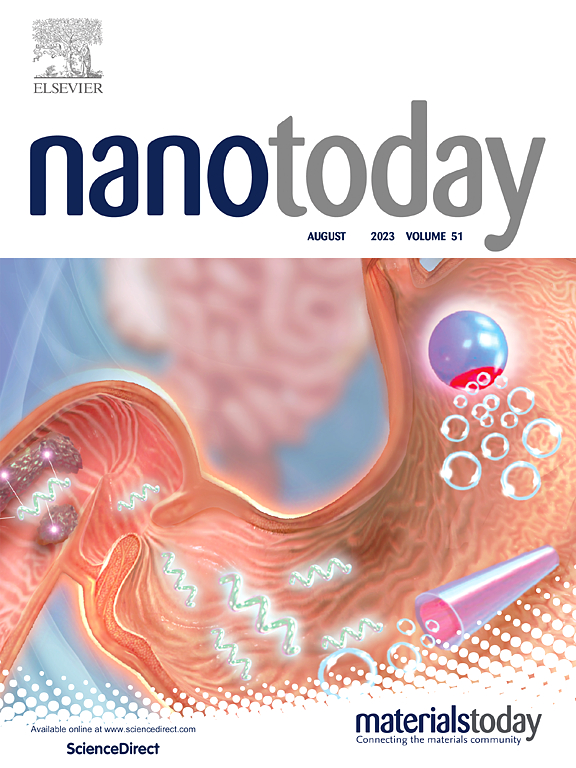通过抗肿瘤免疫连续给药系统实现铁蛋白沉积-免疫疗法 "循环 "的时空协调
IF 13.2
1区 材料科学
Q1 CHEMISTRY, MULTIDISCIPLINARY
引用次数: 0
摘要
γ干扰素(IFN-γ)和铁能诱导铁凋亡;然而,不同的靶点限制了它们在简单联合治疗中的协同疗效。在此,我们构建了两种具有相同聚合物骨架但不同有效载荷的纳米平台,分别靶向抗原递呈细胞(APC)和肿瘤细胞,在免疫疗法中放大铁凋亡作用。带负电荷的 2′,3′-环 GMP-AMP 以电子方式载入 pH 值响应型纳米粒子(PNPs@cGAMP)中,从而激活 APCs 中的干扰素基因刺激器(STING)通路,并伴随着 IFN-γ 分泌的免疫反应激活级联,以促进肿瘤的铁凋亡。戈西泊通过形成对 pH 值敏感的希夫碱与聚合物链共轭,进一步与铁 (Fe3+) 配位,自组装成另一种尺寸可调的纳米药物(PGNPs@Fe)。在酸性肿瘤微环境中,PGNPs@Fe 会收缩成 Gos@Fe,以便更深入地穿透肿瘤,而 Gos@Fe 则会分解成 Fe3+ 和棉酚,生成过氧化脂质,导致铁细胞凋亡和免疫性细胞死亡。与多次施用单一纳米制剂相比,这种嗜铁-免疫疗法 "循环 "在皮下异种移植和远端转移的 B16F10 肿瘤模型中显示出明显提高的抗肿瘤活性。与免疫检查点阻断相结合后,小鼠存活率明显延长。这种设计强调了有效载荷的时空协调,为未来临床应用中的智能纳米治疗组合提供了新的视角。本文章由计算机程序翻译,如有差异,请以英文原文为准。
Spatiotemporal orchestration of a ferroptosis-immunotherapy “cycle” via a sequential drug delivery system for antitumor immunity
Interferon-gamma (IFN-γ) and iron can induce ferroptosis; however, distinct target sites restrict their synergistic therapeutic efficacy in simple combination therapy. Herein, two nanoplatforms are constructed with the same polymeric skeleton but different payloads to separately target antigen-presenting cells (APCs) and tumor cells for amplified ferroptosis in immunotherapy. Negatively charged 2′,3′-cyclic GMP-AMP is electronically loaded in pH-responsive nanoparticles (PNPs@cGAMP), which activates the stimulator of interferon gene (STING) pathway in APCs, accompanied by an immune response activation cascade with IFN-γ secretion for tumor ferroptosis. Gossypol is conjugated to the polymer chain by forming a pH-sensitive Schiff base that further coordinates with ferric iron (Fe3+) to self-assemble into another size-switchable nanoprodrug (PGNPs@Fe). In the acidic tumor microenvironment, PGNPs@Fe shrinks into Gos@Fe for deeper tumor penetration, which disassembles into Fe3+ and gossypol for lipid peroxide generation, resulting in ferroptosis and immunogenic cell death. Compared to multiple administrations of a single nanoformulation, this ferroptosis-immunotherapy "cycle" exhibits notably improved antitumor activity in subcutaneous xenograft and distal metastatic B16F10 tumor models. The mouse survival rate is significantly prolonged after combination with immune checkpoint blockade. This design emphasizes the spatiotemporal orchestration of payloads and provides novel perspectives on intelligent nanotherapeutics combinations for future clinical applications.
求助全文
通过发布文献求助,成功后即可免费获取论文全文。
去求助
来源期刊

Nano Today
工程技术-材料科学:综合
CiteScore
21.50
自引率
3.40%
发文量
305
审稿时长
40 days
期刊介绍:
Nano Today is a journal dedicated to publishing influential and innovative work in the field of nanoscience and technology. It covers a wide range of subject areas including biomaterials, materials chemistry, materials science, chemistry, bioengineering, biochemistry, genetics and molecular biology, engineering, and nanotechnology. The journal considers articles that inform readers about the latest research, breakthroughs, and topical issues in these fields. It provides comprehensive coverage through a mixture of peer-reviewed articles, research news, and information on key developments. Nano Today is abstracted and indexed in Science Citation Index, Ei Compendex, Embase, Scopus, and INSPEC.
 求助内容:
求助内容: 应助结果提醒方式:
应助结果提醒方式:


